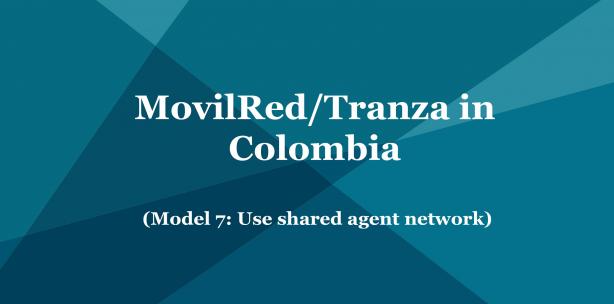
The Solidda group in Colombia originated as a prepaid airtime distribution network, which originally used scratch cards and then started using electronic vouchers. It has aggregated 60,000 retail outlets selling airtime under the MovilRed brand. In 2011, Solidda saw the opportunity to extend its service range by offering cash and electronic services for banks under the agency model, and set up a separate company called Tranza S.A.S. for this purpose. From the beginning it sought to become a multi-bank network, and refused to grant exclusivity to any bank.
Download the full case study by clicking on the 'download' button
The first bank to engage Tranza was Banco Caja Social in 2012, when Tranza had 3,000 stores acting as sub-agents, and it was followed shortly thereafter by the state-owned Banco Agrario, which needed greater outreach to distribute the government´s conditional cash transfers. Tranza currently serves eight banks through 8,000 outlets, including Banco de Bogotá, which is the second largest bank in Colombia. These banks mainly look to Tranza as an agent network to decongest their branches, and to capture additional bill payments
As well as enabling customers to access account-based services (such as deposits, withdrawals, loan repayments, and bill payments), Tranza outlets also let customers pay bills directly over the counter (i.e. with cash rather than through a bank account). Tranza channels such bill payments through one of its member banks, since as a non-bank bill collector it would incur a transaction tax (a flat rate of 0.4% of the transaction amount, called the cuatro por mil), which would make the service financially unviable. To avoid conflicts between member banks, Tranza´s policy has been to channel cash-based bill payments through the member bank that was the first to offer bill payments for each separate billing organisation.
Tranza is happy to remain a low-touch service channel for existing bank customers. It does not sell new accounts through its outlets, as Colombian regulation permits simplified accounts to be opened by prospective customers directly from their mobile phones. And it does not see itself incurring the agent training costs that would be required to turn its network into a product promotion channel.
Tranza places a banner at all its agent locations showing the logos of all the banks for which it offers agency services. Customer fees vary by bank, and these are listed in individual price sheets which every agent must keep in its premises. But some 98% of customer transactions incur no charge (such as bill payments, deposits, collection of conditional cash transfer benefits, and withdrawals for some banks), so service pricing transparency is not a prominent customer protection concern.
Each of Tranza´s 8,000 agents is equipped with a computer through which transactions are logged, a barcode reader to facilitate the capture of account information when customers pay bills, and a printer to issue receipts.
All agent transactions occurring through Tranza´s network of stores are made against Tranza´s account with the relevant bank, rather than the store´s. (This is done, again, to avoid incurring the cuatro por mil transaction tax, as transactions between banks and their agents are exempted from the tax but transactions between agents and their sub-agents are not.) Stores themselves do not need to have, and typically do not have, their own bank account. Tranza therefore maintains a credit exposure with each of its stores, to the extent that they take cash from the public (as is most often the case given the predominance of the bill payment service). Tranza assigns a credit exposure limit to each store, of between US$ 500 and US$ 20,000 depending on expected transaction volumes, and outlets cannot transact any more once they hit their limit. Stores can clear their credit exposure by depositing cash into Tranza´s account at any Colombian bank.
Tranza´s agent locations serve as pay-out points for the national social welfare programs (such as the Familias en Acción conditional cash transfer program, the senior citizen support program Adulto Mayor, and other programs to support victims of terrorism and people displaced by conflict), which the government pays through the Banco Agrario. Tranza supports this by transporting the cash directly to disbursing outlets.
All banks offer Tranza a line of credit to finance the float account that Tranza must maintain with them. This line of credit, which can go up to US$ 20,000 per outlet, is given to Tranza, and not to its stores. As the bank agency business has grown, Tranza now finds itself occasionally hitting the overall credit ceiling that a bank´s risk department sets for individual borrowers.





